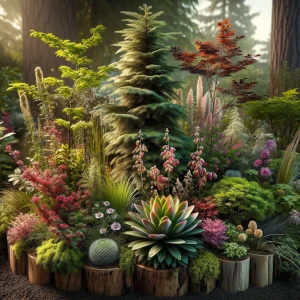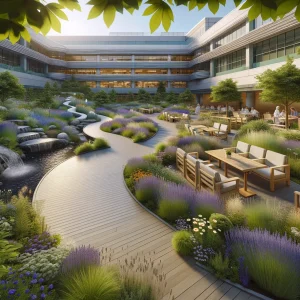Landscaping isn’t just about aesthetics; instead, it’s about creating environments that thrive and heal. For professional landscapers in British Columbia, the stakes are high, and the opportunities are vast. This blog explores two critical aspects of modern landscaping: promoting biodiversity in commercial spaces and designing therapeutic landscapes in healthcare facilities.

Biodiversity in Commercial Landscaping in British Columbia
Why Biodiversity Matters
Biodiversity is crucial in commercial landscaping for several reasons. Ecologically diverse landscapes support local wildlife and contribute significantly to greater environmental sustainability. Moreover, they enhance the soil and regional ecosystems’ resilience, enabling them to handle extreme weather, pests, and diseases better. Importantly, aesthetically diverse plantings create visually engaging spaces that evolve with the seasons, offering a dynamic beauty that monotonous landscapes cannot match.
Achieving Biodiversity
In British Columbia, landscapers have a unique palette of native plants that can enhance biodiversity while maintaining visual appeal and ecological health. Specifically, including native species like the Western Red Cedar and Douglas Fir can provide excellent habitats for local wildlife while anchoring soil structures. Additionally, incorporating smaller flowering plants such as the Pacific Dogwood or the Kinnikinnick can attract pollinators, thereby adding life and movement to the landscape.

Example Project: The Richmond Business Park has integrated a variety of native shrubs and trees, thus creating a series of green corridors that facilitate wildlife movement and reduce urban heat island effects. This strategic integration has, therefore, enhanced the site’s ecological function and increased property values through improved curb appeal.
Practical Strategies
- Plant Selection: Opt for plants native to British Columbia for better adaptability and ecological support.
- Layered Planting Designs: Implement a multi-layer approach with trees, shrubs, and ground covers to mimic natural ecosystems.
- Seasonal Planning: Consider plant species that will flourish in different seasons to maintain year-round interest and ecological support.

Therapeutic Landscapes in Healthcare Facilities
Design Principles
The core principle behind therapeutic landscapes in healthcare settings is to foster environments that actively contribute to patient recovery and well-being. Consequently, these landscapes should offer peaceful, restorative spaces where patients and staff can find solace from the stress of medical environments.
Implementing Therapeutic Design
Case Study: The Vancouver General Hospital’s Healing Garden is purposefully designed to support recovery. The garden features smooth, accessible pathways lined with fragrant lavender and chamomile, known for their calming properties. Moreover, seating areas are strategically positioned to overlook soft grasses and gentle water features, thus creating a multisensory experience that research shows can significantly reduce patient recovery times.



Practical Advice
- Sensory Elements: Include elements that engage different senses, such as fragrant plants, rustling leaves, and gentle water features.
- Accessibility: Ensure that wide and flat pathways accommodate wheelchairs and other mobility aids.
- Private Spaces: Design small, secluded areas where patients can have moments of solitude, essential for mental health.
In conclusion, for landscapers in British Columbia, thoughtful design has the potential to profoundly impact both the environment and human health. Whether enhancing biodiversity in commercial projects or crafting healing spaces in healthcare facilities, ecological and therapeutic design principles can lead to landscapes that look good and do good.